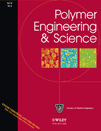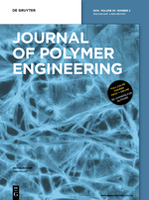
Advanced Industrial and Engineering Polymer Research
Scope & Guideline
Advancing Knowledge in Materials Science
Introduction
Aims and Scopes
- Polymer Compatibility and Compatibilization:
The journal extensively covers the compatibility of various polymer systems, including biopolymers and recycled materials. Studies focus on strategies for compatibilization to enhance the performance and processability of polymer blends and composites. - Flame Retardancy and Fire Safety:
A significant area of research within the journal is the enhancement of flame retardancy in polymers. This includes the development of novel flame retardants and the examination of their effectiveness in different polymer matrices. - Biopolymers and Sustainable Materials:
Research on biodegradable and biopolymer systems is prevalent, reflecting a commitment to sustainability. This includes the exploration of biopolymer-based composites and their applications in various industries. - Nanocomposites and Advanced Materials:
The journal highlights advancements in the field of nanocomposites, focusing on their synthesis, characterization, and applications. This includes the incorporation of nanomaterials to improve mechanical, thermal, and barrier properties. - Additive Manufacturing and 3D Printing:
There is a growing emphasis on additive manufacturing techniques, especially regarding the processing and properties of polymer-based materials suitable for 3D printing applications.
Trending and Emerging
- Sustainable and Biodegradable Polymers:
There is a marked increase in research focusing on sustainable materials, particularly biodegradable polymers and their applications in various sectors, reflecting a global trend towards environmental sustainability. - Advanced Flame Retardant Systems:
Emerging studies are exploring novel flame retardant materials and their mechanisms of action, indicating a growing concern for fire safety in polymer applications, particularly in construction and textiles. - Integration of Nanotechnology in Polymers:
The incorporation of nanotechnology into polymer systems is a rapidly growing theme, with research focusing on enhancing material properties and functionalities through the use of nanomaterials. - Biomedical Applications of Polymers:
Research on polymers tailored for biomedical applications is gaining traction, encompassing drug delivery systems, tissue engineering, and biocompatible materials, reflecting the increasing intersection of polymer science with health care. - Smart and Responsive Polymer Systems:
The development of smart polymers that respond to environmental stimuli (such as temperature, pH, or light) is emerging as a key area of interest, indicating a shift towards multifunctional materials with advanced capabilities.
Declining or Waning
- Conventional Polymer Recycling Techniques:
While recycling is still a focus, conventional recycling techniques are receiving less attention as new, innovative recycling methods and biodegradable alternatives gain prominence. - Traditional Thermosetting Composites:
Research centered on traditional thermosetting composites is declining, as the field shifts towards exploring more environmentally friendly and versatile materials that can meet modern demands. - Static Mechanical Properties Analysis:
There appears to be a waning interest in purely static mechanical properties analysis of polymers, with a shift towards dynamic and multifunctional properties that reflect real-world applications. - Non-Biodegradable Polymer Innovations:
Research on new non-biodegradable polymers is less frequent, as there is a broader societal push towards sustainability and the development of biodegradable options. - Basic Polymer Characterization Techniques:
The focus on basic polymer characterization methods is decreasing in favor of more advanced and multifaceted analytical techniques that provide deeper insights into material behaviors and properties.
Similar Journals

INTERNATIONAL JOURNAL OF POLYMER ANALYSIS AND CHARACTERIZATION
Pioneering research in analytical chemistry and polymers.International Journal of Polymer Analysis and Characterization is a distinguished scholarly publication dedicated to the field of polymer science, with a focus on innovative methodologies and significant advances in the analysis and characterization of polymeric materials. Published by Taylor & Francis Ltd in the United Kingdom, this journal serves as a vital resource for researchers, professionals, and students deeply engaged in Analytical Chemistry, Chemical Engineering, and Polymer Science. With a convergence spanning from 1995 to 2024, it holds a Q3 ranking in the 2023 category quartiles for its valuable contributions to the fields of Analytical Chemistry, Chemical Engineering, and Polymers and Plastics. Despite being a non-open access publication, its rigorous peer-review process and comprehensive coverage of current trends ensure that the journal remains a crucial platform for disseminating impactful research. The journal is indexed in various databases, underscoring its relevance and quality in the academic community. Exploratory studies and articles that push the boundaries of polymer analysis find a welcoming home within these pages, making it an essential read for those aiming to stay at the forefront of polymer research.

Polymer-Plastics Technology and Materials
Fostering Knowledge in Cutting-Edge Materials SciencePolymer-Plastics Technology and Materials is a premier academic journal published by Taylor & Francis Inc., dedicated to the dynamic fields of chemical engineering, materials chemistry, and polymers and plastics. With an impact factor that reinforces its reputation, this journal is strategically indexed in Scopus, ranked notably within its categories (Q2), showcasing its influence and relevance in the academic community. Since its inception in 2019, the journal has served as an essential platform for researchers, professionals, and students to disseminate innovative studies and advancements in polymer science and materials technology. As an Open Access publication, it ensures that cutting-edge research is accessible to a global audience, fostering collaboration and knowledge sharing in the material sciences. Located in the United Kingdom, Polymer-Plastics Technology and Materials continues to enhance the dialogue within the industry, addressing critical challenges and exploring emerging trends that shape the future of polymer and plastics technologies.

POLYMER ENGINEERING AND SCIENCE
Pioneering Research in Polymer ApplicationsPOLYMER ENGINEERING AND SCIENCE, published by WILEY, is a premier journal specializing in the field of polymer science and engineering. Since its inception in 1961, this journal has been at the forefront of disseminating high-quality research, focusing on various aspects of polymers and plastics, including their chemistry, properties, and applications. With an impressive impact factor, it ranks in the second quartile (Q2) across multiple categories, including Chemistry (Miscellaneous), Materials Chemistry, and Polymers and Plastics, showcasing the journal's significance and influence in these vital areas of research. Researchers and professionals in academia and industry will find the latest advancements and innovative methodologies in polymer science, making this journal an essential resource for those looking to stay updated on cutting-edge developments. While it does not currently support Open Access, its comprehensive scope and critical insights positioned it as a valuable platform for advancing knowledge and fostering collaboration within the polymer community. The journal’s office is located at 111 River St, Hoboken 07030-5774, NJ, United States, emphasizing its strong presence in the academic landscape.

JOURNAL OF VINYL & ADDITIVE TECHNOLOGY
Elevating Standards in Vinyl and Additive ResearchJOURNAL OF VINYL & ADDITIVE TECHNOLOGY, published by Wiley, is a pivotal resource in the fields of Chemical Engineering, Chemistry, and Materials Science, offering a platform for the dissemination of cutting-edge research from 1989 to the present. With its ISSN 1083-5601 and E-ISSN 1548-0585, the journal operates from the UK and is notable for its diverse coverage, including insights into polymers, plastics, and innovative marketing strategies specific to this niche. Holding a commendable positioning within the Q2 category in Chemical Engineering and Chemistry, alongside notable ranks in Materials Chemistry and Marketing, this journal delivers impactful research essential for professionals, academics, and students alike. Though not an Open Access journal, it is indexed in prestigious databases, ensuring accessibility to vital findings in vinyl and additive technology. Researchers looking to stay at the forefront of material innovations will find this journal an invaluable asset.

Express Polymer Letters
Exploring the Frontiers of Polymer KnowledgeExpress Polymer Letters is a leading open-access journal published by BUDAPEST UNIVERSITY OF TECHNOLOGY AND ECONOMICS, focusing on the fast-paced realm of polymer science and engineering. With a broad scope that encompasses the interdisciplinary fields of Chemical Engineering, Materials Chemistry, and Organic Chemistry, the journal serves as a crucial platform for researchers and professionals dedicated to advancing knowledge and innovation in polymer-related disciplines. Since its inception in 2007, it has consistently provided high-quality, peer-reviewed research and has achieved a respectable impact within various categories, evidenced by its Q2 quartile rankings across multiple Scopus categories and its competitive standings in the field. The journal's dedication to open access ensures that research is widely disseminated, promoting transparency and collaboration within the academic community. Positioned to converge into the future, Express Polymer Letters remains an essential resource for cutting-edge studies and developments, with an anticipated convergence period extending through 2024.

JOURNAL OF POLYMER ENGINEERING
Elevating Knowledge in Chemical Engineering.JOURNAL OF POLYMER ENGINEERING, published by Walter de Gruyter GmbH, stands as a pivotal platform in the field of polymer science and engineering. With an ISSN of 0334-6447 and an E-ISSN of 2191-0340, this journal has been a vital contributor to the academic landscape since its inception, spanning publications from 1981 to 2024. As a recognized entity in the realms of Chemical Engineering, Materials Chemistry, and Polymers and Plastics, it holds a respectable position in Q3 quartile rankings according to the latest assessments. The journal is positioned to promote the exchange of cutting-edge research findings, technological advancements, and critical reviews that address the complexities of polymer application and innovation. Researchers and professionals will find a wealth of information, from experimental methodologies to theoretical analyses, all designed to inspire and elevate the current understanding of polymer engineering. By fostering collaboration and dissemination of knowledge, the JOURNAL OF POLYMER ENGINEERING remains crucial for advancing research and education in its specialized domains.

JOURNAL OF POLYMER RESEARCH
Illuminating Innovations in Materials ChemistryJOURNAL OF POLYMER RESEARCH is a leading peer-reviewed journal published by SPRINGER, specializing in the dynamic fields of polymer science, materials chemistry, and organic chemistry. Operating since 1994, this esteemed journal has consistently delivered high-quality research articles that illuminate the latest advancements and innovations in polymer technology. With an increasing impact factor and placed in the Q2 category for both Materials Chemistry and Polymers and Plastics, it stands as a valuable resource for researchers, professionals, and students seeking cutting-edge knowledge in these areas. The journal is indexed in Scopus, highlighting its significance in the academic community, with notable rankings in Materials Science and Organic Chemistry. While it does not currently offer open access options, the meticulous selection of research and thorough peer-review process ensures each article's contribution to the field is both robust and impactful. Researchers aiming to expand their understanding and engage with pioneering studies will find JOURNAL OF POLYMER RESEARCH an indispensable platform.

MACROMOLECULAR MATERIALS AND ENGINEERING
Empowering Discoveries in Polymer Science and BeyondMACROMOLECULAR MATERIALS AND ENGINEERING, published by Wiley-VCH Verlag GmbH, is a distinguished open-access journal that since its inception in 1989 has been at the forefront of research in the fields of Chemical Engineering, Materials Chemistry, and Polymer Science. Recognized with a top-tier Q1 ranking in multiple categories for 2023, including Chemical Engineering and Organic Chemistry, this journal facilitates cutting-edge discoveries and advancements by providing a platform for authors to share innovative findings. With an impressive Scopus ranking, positioned within the top percentiles in several interdisciplinary categories, MACROMOLECULAR MATERIALS AND ENGINEERING is an essential resource for researchers, professionals, and students who are engaged in the development and application of macromolecular materials. As an open-access journal since 2023, it enhances accessibility and fosters collaboration within the global scientific community. The journal, headquartered in Germany, aims to publish high-quality, peer-reviewed articles that drive the scientific dialogue forward in the rapidly evolving fields of materials science and engineering.

POLYMER-KOREA
Advancing the Frontiers of Polymer ResearchPOLYMER-KOREA, an esteemed publication by the POLYMER SOC KOREA, serves as a vital platform for disseminating groundbreaking research in the domains of Chemical Engineering, Materials Chemistry, and Polymers and Plastics. Founded in 1996, this journal aims to bridge the gap between academic inquiry and industrial application, fostering innovation in polymer science. With an ISSN of 0379-153X and an E-ISSN of 2234-8077, POLYMER-KOREA provides a rigorous peer-reviewed environment, although it does not currently offer open access options. Based in Seoul, South Korea, and slated for converged years up to 2024, the journal is indexed in Scopus and has been ranked in the 2023 Q4 category in its respective fields, highlighting its niche yet competitive position within the academic community. Researchers, professionals, and students alike will find the journal an invaluable resource, honing in on critical advancements and fostering collaborative discussion within the spectrum of polymer science.

ADVANCES IN POLYMER TECHNOLOGY
Empowering Innovation in Polymer Science.ADVANCES IN POLYMER TECHNOLOGY is a premier open-access journal that has been at the forefront of innovation in the field of polymer science and engineering since its inception in 1981. Published by WILEY-HINDAWI, this journal serves as a vital platform for researchers, professionals, and students alike, facilitating the dissemination of cutting-edge research and applications in chemical engineering, organic chemistry, and polymers and plastics. With an impact factor that signifies its relevance and quality, the journal has achieved notable rankings, including Q2 in Chemical Engineering, and ranks within the top 30% of its category in multiple disciplines as of 2023. ADVANCES IN POLYMER TECHNOLOGY has embraced open-access publishing since 2019, ensuring that research findings are widely available to the global academic community. With its comprehensive coverage of topics related to polymer technology, this journal not only fosters scholarly exchange but also aims to bridge the gap between fundamental research and practical applications, thereby contributing significantly to advancements in materials science.